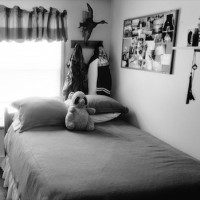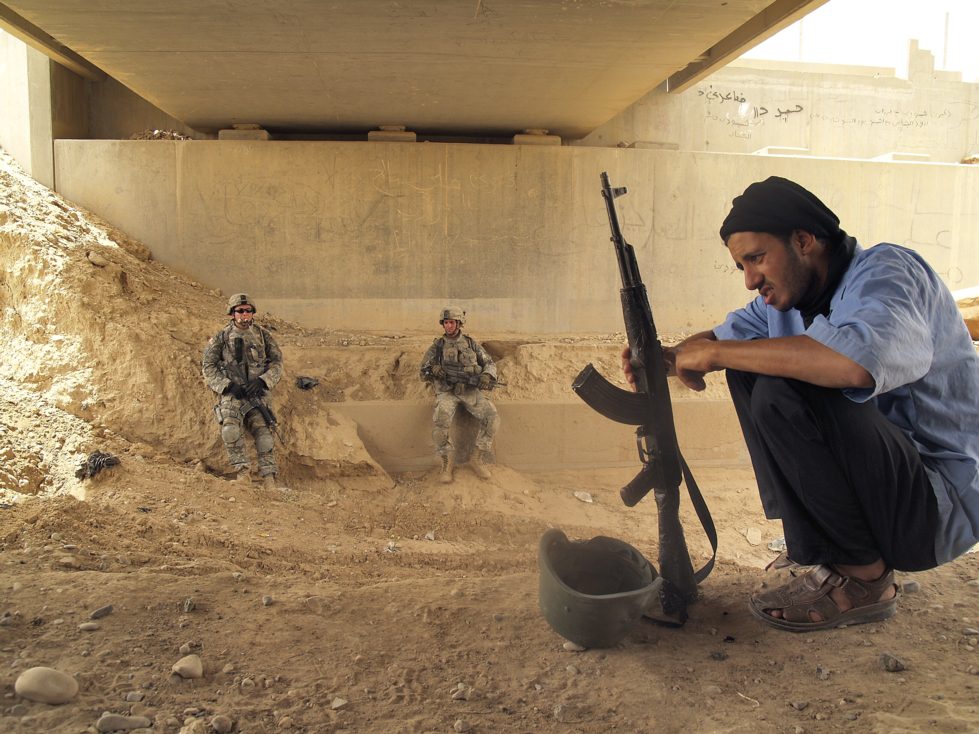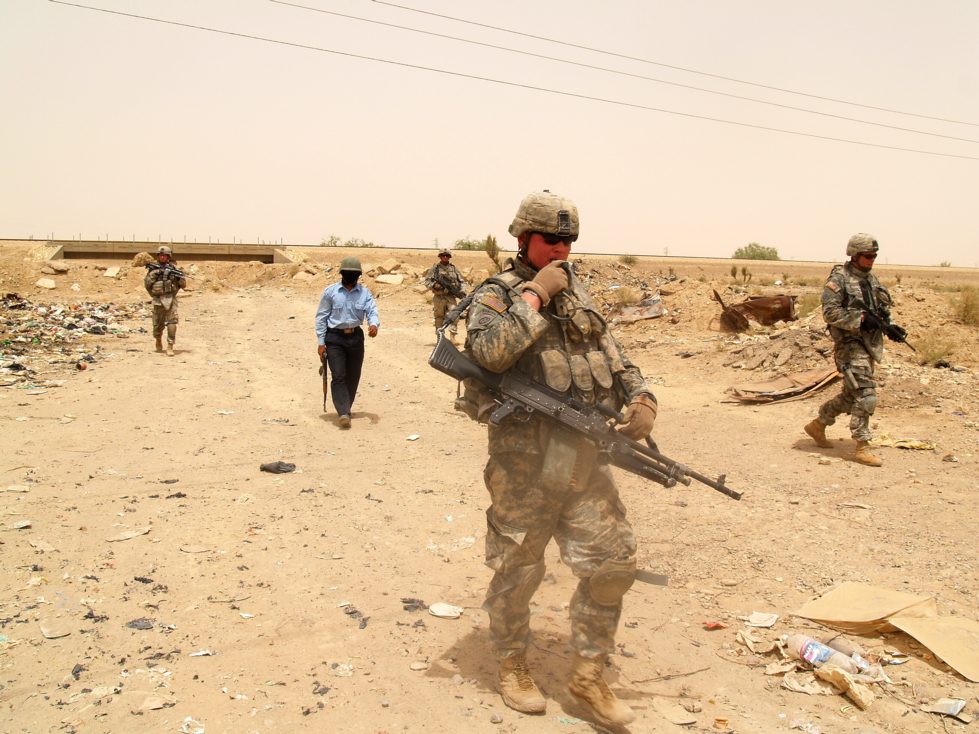Longtime conflict photographer Ashley Gilbertson’s essay “Absences” accompanies his photobook Bedrooms of the Fallen. The essay is about his memories of Lance Corporal William Miller. The Marine died in November 2004 when Miller’s fire team took Gilbertson up a mosque’s minaret in Fallujah so that Gilbertson could take a picture of a dead insurgent fighter for the New York Times. The image would verify that insurgents were using mosques as fighting positions, in violation of the Geneva Convention. Miller was shot by a still-living insurgent in that minaret—all the necessary proof.
“I was in too much shock to photograph Miller being carried away,” Gilbertson writes, “but if I had taken pictures, they would have depicted a crumpled, dying man… Those kinds of images show the horror and repugnance of war… But they don’t speak to the larger truth: war takes people away from those who love them. I came home. Billy Miller didn’t. I needed to photograph his absence.”
Gilbertson writes that his wife Joanna became frustrated that the “soulless military headshot” made it difficult to identify with fallen soldiers who are rendered all alike, with stoic expressions before the same American flag. In Iraq or Afghanistan, soldiers’ faces were hidden behind dark sunglasses and shaded by helmets, bodies were turtled by armor—a form of anonymity “perpetuated by those of us in the press,” Gilbertson writes, “only showing images of who they were at war.”
Joanna told him, “You need to photograph their rooms.”
Bedrooms of the Fallen captures 40 soldiers and veterans in a form of vibrant life, even if each man and woman’s presence is sometimes more than a decade gone. Karina Lau died in a helicopter crash on Nov. 2, 2003; in Gilbertson’s photograph from December 2009 it looks like she simply straightened up before leaving for the day, resting a stuffed bunny on her pillow. A clue to her absence is the framed, folded American flag placed on her desk, watched over by a crucifix hanging on the wall. It’s a tiny window into Karina Lau’s once-life, and it’s certainly more personal than what Gilbertson calls the “boilerplate obituary. . .in the next day’s paper” that often remains digitally accessible but rarely current.

Gilbertson writes, “Our bedroom was the space we took ownership of, and in it we placed the things we loved most, reminders of what we longed for and aspired to. There we could express ourselves without judgment, and only our mothers could make us clean it.”
Of course, each bedroom connects with families and friends, who must understand the significance of the items on walls and shelves. Did Lieutenant Brian Bradshaw really hang a Declaration of Independence on his wall, above his pillow, so it would practically be the first thing he saw in the morning? It takes a certain personality to do that, and my cynicism says he would have outgrown it in a few years—that an older Brian Bradshaw would laugh at the likely-strident patriotism of his youth. Still, he was from a military family; maybe he was raised to expect that from himself.
“‘After a man looks at these photographs, what, in his heart of hearts, do you want him to feel?’” was a question a father put to Gilbertson.
“I said I wanted people to realize that these weren’t just names and ranks of people who had died in a foreign place. I wanted the dead to be remembered,” Gilbertson replied.
A sign propped on a heating grate in Ronald Winchester’s bedroom reads: “1st Lt. Ronald D. Winchester Rd.” He died in September 2004; the street he lived on in Rockville Center, New York was rededicated in his name in November 2009; in February 2011, Gilbertson photographed his bedroom with a Marine Corps blanket, a Marine’s dress headgear displayed on top, and a framed, folded American flag sitting on the pillow. The street name change is permanent, true, but it is co-named with Greystone Road, and that’s the name that shows up in Google. They’re valiant, but brief, these attempts at remembrance.
Gilbertson’s project began as the photo essay “The Shrine Down the Hall,” which won a National Magazine Award for the New York Times. A successful Kickstarter project enabled Gilbertson to document more bedrooms, including several belonging to European soldiers. In an interview after winning the award, Gilbertson said that the Bedrooms project “was in response to my failed work in Iraq. It was about the failure of people to engage with the pictures I took while I was there and, I think, my failure as a photographer to present them freshly.”
But is it enough to “engage with?”
My own photographs from Iraq often seem like moments from another life.
One image rises above the rest. It’s a simple photo: three guys—an Iraqi cop and two US soldiers—wait under a railroad bridge, a break during a long patrol. I had arrived three days before, embedding as a freelance photojournalist with Charlie Company, 1st/505th Parachute Infantry Regiment, 82nd Airborne Division. I was once in the Army; I was even in Iraq, back in 1991. But to the young soldiers that barely counts.
When we reached the bridge, I was content to take a short break in the shade. At 11:55 a.m., July 19, 2007, I raised my camera and framed the Iraqi and the two soldiers. With a second shot I zoomed in on the two men across from me—PFC Ben Gwaltney and Staff Sgt. Charles Patterson. Then I zoomed out to capture all three men again.
Only the first shot works. The second is out of focus. In the third, the Iraqi raises his arm and blocks his face. At 12:01 p.m., I turn to my right and take two close-ups of the soldier resting next to me, Spec. Daniel Bishop. His face glistens with a sweaty sheen. The Iraqi policeman notices my picture taking and tries to make conversation, but it goes nowhere. “No hablas Arabique,” Bishop mumbles. I recognize the Arabic word ha’ar, for “hot.” I repeat it back to the Iraqi and we both chuckle. In my mind, I can translate the rest of what the Iraqi probably said, in the language of soldiers, hot, tired and at war: Ain’t this a bitch.
I know it would have been difficult for Gilbertson to include an Iraqi bedroom in his collection, but it’s a melancholy absence considering all the men who fought alongside the U.S. soldiers in their own country. Like the Iraqi in my picture, sweating and hot. Trying to chat about the bullshit, like soldiers always do.
When we depart, I turn around to take a picture of Spec. Tim Vergo drinking from a CamelBak tube. The bridge recedes behind us. It’s 12:05 p.m.
My first photo of the men under the bridge comes out perfectly. The depth of field kept all three men in crisp focus; the Iraqi cop didn’t mug for the camera; the framing puts the Iraqi in the foreground, leading the eye to the Americans in the middle; neither the Iraqi nor Gwaltney wears sunglasses or ski masks to hide their expressions of exhaustion. I like specificity. The photo’s proper name is “Break Beneath a Bridge, Bayji, Iraq, July 19, 2007.”
I first saw Gilbertson’s Bedrooms gallery in February 2011 when I supported his Kickstarter project. I looked at the dates each soldier had died, to see if the dates corresponded with my own time in Iraq. There were three, all from 2007: Spec. Zachary Clouser, July 18, Cpl. Christopher Scherer, July 21, and Cpl. Brandon Craig, from Earleville, Maryland, July 19.
Craig’s bedroom is like the others. There is the American flag, sometimes folded, sometimes hanging on a wall; there is a family picture; there is a stuffed animal. The distinctions come with closer looks. Craig’s uniform hangs in his room, 2nd Infantry Division patches on each shoulder. His graduation tassel dangles from a shelf. Antlers are mounted on the wall above a picture of Craig on a hunting trip posing with a deer. Two gifts, wrapped in Christmas paper by Brandon’s father Danny, rest on his dresser. “After Brandon had turned eighteen, [he] had jokingly complained that he no longer received toys, “Somethin’ to play with!” he’d said. So Danny began a family tradition,” Gilbertson wrote, “buying his adult children toys every Christmas. Two Christmases had passed since Brandon had died, and the two presents were from his dad, lovingly wrapped, his son’s name carefully written on the paper.”
Each bedroom contains something unique like this, for those who look closer at Gilbertson’s photos. I looked into Brandon Craig online, and found obituaries with vague information. He died from “wounds sustained from an improvised explosive device.” So I wanted to know when. I wanted to dig a little deeper. But looking closer might uncover something you didn’t expect, a convergence you might not want.
The Iraq War Logs entry documents the attack on Craig’s convoy of five Strykers: “At 191204JUL07, BDE TAC (Raider 3) in the Baghdad Province reported IED Strike with subsequent SAF from the south in Hussaniyah on RTE Mississippi. Initial report had 2 WIA, 1 litter urgent, 1 litter priority… At 191242JUL07 Bandage OPS lifted off and headed to Balad. Additionally BDE S-3 (Raider 3) reported that the litter urgent WIA died of wounds, therefore 1 KIA that would be brought back with Raider TAC convoy.”
The attack happened on July 19, 2007 at 12:04 p.m.
At 11:55 a.m., I’m centering my photo of the three men, “Break Beneath a Bridge.”
I face due south, toward Hussaniyah, and what Google calls an “unnamed road” at Latitude 33.55, Longitude 44.39, about 125 miles away as the crow flies.
If I’d had the widest-angle lens, if I could take anything in an infinite line of sight into the camera’s telephoto, I could have zoomed out from underneath that bridge to Craig’s convoy of five Strykers. Guys crammed inside the lead vehicle’s tight compartment, in the crew hatch and the driver’s seat, while two or three likely looked out the hatches in the middle and the rear. They drank from CamelBaks or passed each other semi-cool cans of Rip-Its. They made small talk or stared into space. July 19, 2007, at 11:55 a.m.
By 12:05, I’m walking away from the bridge, turning to take a final picture.
Gilbertson wrote, “I wanted people to feel the loss as one of our own.”
I lost my photo. Part of it, anyway. I lost some of the painless pride of ownership, the selfish satisfaction of creation. Now I know what else was going on and it was better when I didn’t, even if I’m glad that I do.
Gilbertson closes his book with a scene of a mother who lost her veteran son to suicide. “She put [his] shirt to her nose,” Gilbertson writes, “and inhaled her son’s scent.”
It’s not Brandon Craig’s empty bedroom in Earleville, Maryland. It’s full of memories of all that Brandon Craig still is.







